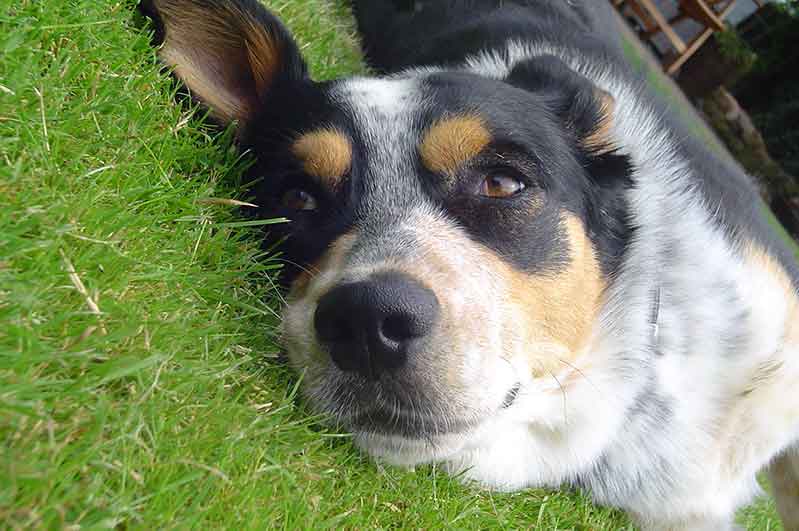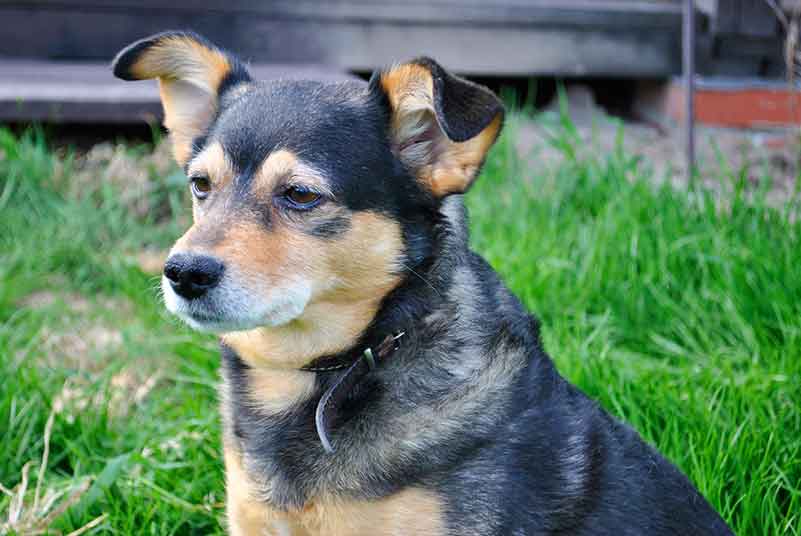Jack Russell Blue Heeler Mix (Russell-Heeler) – Hybrid Dog Breed
Russell-Heeler is a hybrid dog breed resulting in Jack Russell Terrier and Blue Heeler (Australian Cattle Dog) mix. I’m sure this name sounds familiar to you if you are a dog fan, but this might not be a very familiar name for some.
Either way, today’s article is about Russell-Heelers, and this will help you get a good understanding of this dog breed.
Russell-Heeler, sometimes also known as Cattlejack or Jack-Heeler, is a designer dog breed. In other words, these dogs are developed through two separate dog breeds: Jack Russell Terriers and Blue Heelers.
Inheriting Jack Russell’s and Blue Heeler’s genes, Russell-Heelers become small to medium-sized pleasant dogs with fierce, alert, intelligent, and loyal personalities.
If you plan to have a dog for the first time, you might be in a dilemma thinking about which dog would fit your family the best. It is crucial to do a proper background check before getting yourself a dog.
If you educate yourself with the facts, you will be able to figure out the ideal dog breed for you. Also, no matter what that breed is, you can become a good dog parent. Keep reading to find out whether Russell-Heeler is the dog you’ve been looking for.
Without getting any more time, let’s get started!
Fast Facts of Jack Russell and Blue Heeler Mix (Cattle-Jack Mix)
| Average height | 12 – 18 inches |
| Average weight | 20 – 35 pounds |
| Lifespan | 12 – 16 years |
| Suitable for | Active owners, Families with kids, Couples |
| Temperament | Energetic, Playful, Loyal, Protective, Stubborn |
| Good for families? | Yes |
| Other nicknames | Cattle-Jack, Jack-Heeler, Russell-Heeler |
Origin of Jack Russell And Blue Heeler mix
When was this hybrid dog breed developed? It is complicated to precisely trace the origins of hybrid dogs. However, by going through the history of the parent dogs, we can get adequate knowledge of the origins of their mixed version.
Jack Russell Terrier is a breed coming from England. They were initially bred as hunting dogs during the 1800s.
On the other hand, Blue Heeler is a dog breed developed in Australia in the 1800s. Blue Heelers have a renowned reputation as cattle dogs.
Their hybrid version, Russell-Heeler, does not own extensive history as much as their parents do. Nevertheless, you can now find this mixed dog breed in many countries.
The appearance of JRT And Blue Heeler mix (Cattle-Jack)

The combination of Jack Russell Terriers and Blue Heelers certainly gives Russell-Healers a unique appearance.
These dogs could be either small-sized or medium-sized hence Jack Russells are small-sized dogs, whereas Blue Heelers are medium ones.
Typically a Russell- Heeler could weigh around 20-35 pounds and stand tall up to 12-18 inches. The length of their coat varies from short to medium size.
The coat combines two or three colors, including white, black, tan, blue, and gray. They could have flopped, erect, or semi-erect years.
Although they are not giant dogs, they still have muscular build. In some cases, a Russell-Heeler could get more physical traits from one parent over the other.
How big do Jack Russell And Blue Heeler mix get?
As mentioned already, the parent dogs are significantly different in their body sizes. Therefore one cannot precisely say how big a Russell-Heeler could get.
However, generally, a full-grown Russell-Heeler may have an approximate weight of 25-30 pounds and a height of 13-15 inches.
But keep in your mind that these measures could differ depending on the genes of the parent dogs.
While genes function as the predominant factor deciding their growth, other external reasons such as quality food and sufficient amounts of physical activities also could impact it reasonably.
The temperament of Jack Russell And Blue Heeler mix
Not each and every dog breed have the same personality traits. Sometimes dogs share common temperaments; they also have unique characters depending on their breed.
Russell-Heelers are dogs with outgoing personalities, thanks to their parents. Jack Russell Terriers and Blue Heelers are both dogs with unique and bold characters, and Russell-Heelers are a fair blend of these personalities.
Jack Russells and Blue Heelers are well known for their high energy. Inheriting genes from two highly energetic and active parent breeds, Russell-Heelers also undoubtedly become super energetic dogs.
There’s less room for you to feel bored if you have a Russell-Heeler at your home because these dogs are packed with liveliness.
Furthermore, Russell-Heelers are considered loyal dogs; they adore their owners and bond well. Also, Russell-Heelers are capable watch dogs.
Sometimes they can be somewhat stubborn; mainly, they get this from Jack Russell’s genes. However, it can certainly be mitigated through proper training.
Considering everything, it would be fair to mention that Russell-Heelers have dynamic personalities and make great family friends.
How long do Jack Russell And Blue Heeler mix dogs live?

As we all know, dogs age differently compared to human beings. Despite the breed they belong to, dogs typically live up to 10-12 years.
However, you will notice that this general life expectancy range slightly changes from breed to breed. Some breeds could have a 7-10 years life expectancy, and another breed could have 15 years or even above.
Jack Russell Terriers have a life expectancy of 12-16 years, and Blue Heelers 13-15 years. Both are considered longer life spans for a dog to have. So a healthy Russell-Heeler most probably enjoys a life span of 12-16 years.
How much do Cattle-Jack puppies cost?
It is hard to give a fixed price for any hybrid dog, including Russell-Heelers. Their prize is determined based on a couple of reasons.
Most importantly, the bloodline of the parent dogs, the breeder’s reputation, and the litter size.
A Jack Russell usually costs around 500-1500 US Dollars and a Blue Heeler around 500-1000 US Dollars.
Therefore if you want to have yourself a Russell-Heeler, you will have to spare around 800-1500 US Dollars, but this can go beyond the average range due to previously mentioned factors.
There are instances where you could find these dogs for meager prices, but you have to be very conscious about why they are cheap. It is always better to get the puppies from a certified breeder.
Maintenance tips for Jack Russell And Blue Heeler mix
Having a dog is fun, but you should never deny the responsibilities that come along. If you need to raise a healthy good looking dog, you must know maintenance fundamentals.
It might sound a bit complex, but if you are learning the essentials before getting the dog, it won’t be as complex as you think.
Below you can find some essential tips regarding the general maintenance of this breed and also some other related aspects.
- Follow an appropriate grooming schedule
First things first, make sure that you keep your Russell-Heeler neat and nice. To do that, you must follow a grooming schedule.
It is not complicated to groom Russell-Heelers as they are moderate shedders. Bathing your Russell-Heeler once a month unless a specific need would be enough.
You should brush them once a week to keep their coat smooth and remove the dead hair. It is also essential to clean their ears once a week.
Also, to maintain their oral hygiene, you can brush their teeth a couple of times a week.
- Follow a proper dietary plan
Your Russell-Heeler’s dietary patterns play a crucial role in keeping them healthy and fit. These dogs are very energetic; they have a lot of stamina; therefore, you must give them quality and nutritional food.
The amount of food is decided by the body size of the Russell-Heeler. As we discussed, Russell-Heelers have excellent energy levels and a lot of stamina.
Hence they must have to eat nutritional food. A pup would require four to five meals per day in small quantities, and as they grow, you can increase the meal size but reduce the number of meals to two.
When you feed them human food, be aware of which veggies and meats would suit them. Also, do not overfeed your Russell-Heeler.
- Make them exercise
Physical activities are a must for a Russell-Heeler. These dogs are active by nature, so you will not find it hard to engage them in exercises.
A Russell-Heeler typically requires 30-45 minutes of daily exercise. You can simply provide their regular exercise needs by taking them for a walk or perhaps playing.
- Be attentive to their general health
The more you know about the general health of your Russell-Heeler, the easier you find it to take care of them. Typically, Russell-Heelers tend to be healthy dogs.
However, it is impossible to find a dog without any health complexities. These dogs are also affected by some health conditions that include hip and elbow dysplasia, lens luxation, epilepsy, Cushing’s disease, and deafness.
None of these conditions cause a severe threat to their life, but you should never take them lightly; as soon as you notice sudden and frequent changes in the dog, take them to a vet.
Final thoughts about this Russell-Heeler dog breed
To wrap things up, here are some final thoughts regarding Russell-Heelers.
When you decide to get yourself a dog, Russell-Heeler might not be the first choice that pops up in your mind. However, these dogs have a unique appearance, better temperament, long life span, and most importantly, excellent human companions.
So why not have yourself one of these dogs? I hope you got a good understanding of Russell-Heelers through this article!
Thank you for reading this article! Stay tuned with Jack Russell Owner for more interesting posts about your favorite dog breed.



![JackChi / Jackahuahua [Jack Russell And Chihuahua Mix]](https://jackrussellowner.com/wp-content/uploads/2021/03/JackChi-Jackahuahua-Jack-Russell-And-Chihuahua-Mix-768x439.jpg)

![Jack Russell Pitbull Mix [Jack Pit] Read Before Adopt!](https://jackrussellowner.com/wp-content/uploads/2021/04/Jack-Pit6-768x512.jpg)
![Jack Russell Pug Mix [Jug] Read Before Adopt One!](https://jackrussellowner.com/wp-content/uploads/2021/03/Jug-4-768x514.jpg)

